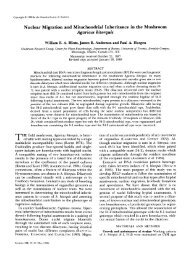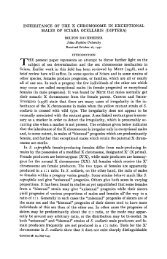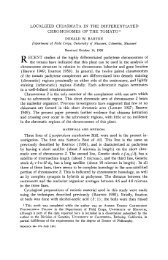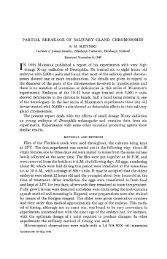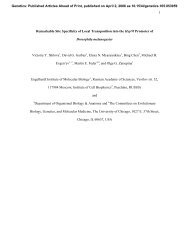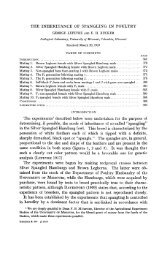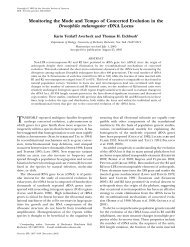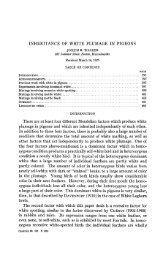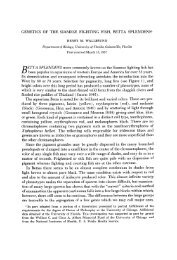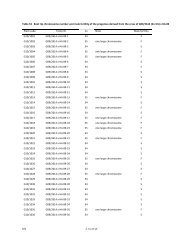abstracts of papers presented at the 1962 meetings - Genetics
abstracts of papers presented at the 1962 meetings - Genetics
abstracts of papers presented at the 1962 meetings - Genetics
Create successful ePaper yourself
Turn your PDF publications into a flip-book with our unique Google optimized e-Paper software.
ABSTRACTS 939<br />
ARAKAKI, DAVID T., (Introduced by JIMMIE B. SMITH), <strong>Genetics</strong> Department, University <strong>of</strong><br />
Hawaii, Honolulu 14, Hawaii: Chromosomal analysis <strong>of</strong> normal and mongoloid individuals <strong>of</strong><br />
uarious ethnic groups in Hawmi.-The chromosomal p<strong>at</strong>terns <strong>of</strong> 32 normal persons were examined<br />
by <strong>the</strong> leukocyte culture technique. Normal samples re<strong>presented</strong> seven different ethnic<br />
groups: Japanese, Chinese, Caucasian, Hawaiian, Korean, Filipino, and Negro. The modal number<br />
<strong>of</strong> 46 was found to characterize <strong>the</strong> chromosomal complements <strong>of</strong> <strong>the</strong>se seven ethnic groups,<br />
<strong>of</strong> which, <strong>the</strong> Korean, Hawaiian, and Filipino groups re<strong>presented</strong> original chromosomal analyses.<br />
In addition, normal karyograms from <strong>the</strong> first four ethnic groups indic<strong>at</strong>ed th<strong>at</strong> no significant<br />
morphological difference existed among <strong>the</strong>m.-Chromosomal p<strong>at</strong>terns <strong>of</strong> 13 mongoloid idiots<br />
were examined by <strong>the</strong> same technique. The modal number for each <strong>of</strong> <strong>the</strong>se p<strong>at</strong>ients was 47, presumably<br />
<strong>of</strong> <strong>the</strong> trisomic-21 type. Analyses <strong>of</strong> <strong>the</strong> chromosomal p<strong>at</strong>tern in several Caucasian,<br />
Japanese, and Hawaiian p<strong>at</strong>ients clearly indic<strong>at</strong>ed a chromosome number <strong>of</strong> 47 with trisomy for<br />
chromosome 21.<br />
BACON, D. F., Institute <strong>of</strong> Microbiology, Rutgers, The St<strong>at</strong>e University, New Brunswick,<br />
N. J.: Sexual transfer <strong>of</strong> <strong>the</strong> Hfr property from <strong>the</strong> K-12 strain to <strong>the</strong> W strain <strong>of</strong> Escherichia<br />
coli.-M<strong>at</strong>ings <strong>of</strong> F+ cultures <strong>of</strong> strain K-12 with auxotrophs <strong>of</strong> strain W yield recombinants with<br />
very low frequency. Several Hfr cultures <strong>of</strong> K-12, however, produce recombinants with W <strong>at</strong><br />
high frequency; in three such cases <strong>the</strong> Hfr property was transferred to <strong>the</strong> W recipient, and<br />
could be recovered after repe<strong>at</strong>ed backcrossings into W. The system studied in gre<strong>at</strong>est detail involved<br />
culture 808 (K-12, Hfr), kindly supplied by DR. F. JACOB; this culture was crossed with<br />
a proline auxotroph (pro-) <strong>of</strong> W and pro+ recombinants were screened for <strong>the</strong>ir ability to transfer<br />
leucine independence (leu+) with high frequency. The kinetics <strong>of</strong> gene transfer were studied<br />
with <strong>the</strong> aid <strong>of</strong> a blendor and with phage T6. In <strong>the</strong> cross, K-12, Hfr 808 x K-12, leu-, <strong>the</strong><br />
leucine marker entered <strong>at</strong> 6.5 minutes and <strong>the</strong> maximum number <strong>of</strong> recombinants was equivalent<br />
to 10% <strong>of</strong> <strong>the</strong> Hfr cells; in <strong>the</strong> crosses, K-12, Hfr 808 x W, leu- and W, Hfr 808 X W,<br />
leu-, <strong>the</strong> leucine marker also entered <strong>at</strong> 6.5 minutes, but <strong>the</strong> maximum recovery <strong>of</strong> recombinants<br />
was 1-2% <strong>of</strong> <strong>the</strong> Hfr cells; in <strong>the</strong> cross W, Hfr 808 x K-12, leu-, recombinants occurred with<br />
low frequency (less than 0.001% <strong>of</strong> Hfr cells). (Aided by <strong>the</strong> U. S. Public Health Service and<br />
<strong>the</strong> Office <strong>of</strong> Naval Research.)<br />
BAILEY, D. W., Cancer Research Institute, University <strong>of</strong> California Medical Center, San<br />
Francisco, California: Histoincomp<strong>at</strong>ibility associ<strong>at</strong>ed with <strong>the</strong> X chromosome in mice.-During<br />
an experiment on induced mut<strong>at</strong>ions <strong>at</strong> <strong>the</strong> histocomp<strong>at</strong>ibility loci, evidence was fortuitously<br />
obtained for <strong>the</strong> existence <strong>of</strong> an unanticip<strong>at</strong>ed source <strong>of</strong> histoincomp<strong>at</strong>ibility.--Grafts were exchanged<br />
between hybrid types in like-sexed groups by means <strong>of</strong> a tail-skin grafting technique<br />
(BAILEY and USAMA, Transplant<strong>at</strong>ion Bull. 7: 424, 1960). Out <strong>of</strong> 36 grafts transplanted in<br />
males from (BALB/c 9 x C57BL/6 8 )F1 to (C57BL/6 9 x BALB/c 8 )F1 hybrids, 31 survived<br />
to five weeks after grafting; 14 to nine weeks. Out <strong>of</strong> 34 grafts made in <strong>the</strong> opposite direction<br />
in males, 16 survived to five weeks after grafting; none, to nine weeks. In contrast, all 80<br />
grafts exchanged between reciprocal hybrids in females survived to nine weeks and beyond.-<br />
Second-set grafts on five F, males were rejected in an average <strong>of</strong> ten days, suggesting th<strong>at</strong> <strong>the</strong><br />
phenomenon under observ<strong>at</strong>ion was immunological in n<strong>at</strong>ure. In order to determine <strong>the</strong> rel<strong>at</strong>ive<br />
roles played by <strong>the</strong> X and Y chromosomes, nine o<strong>the</strong>r sensitized F, males were challenged with<br />
grafts from both parental strains. In all cases it was <strong>the</strong> skin <strong>of</strong> <strong>the</strong> p<strong>at</strong>ernal strain th<strong>at</strong> was rejected.<br />
Moreover, mean survival time <strong>of</strong> <strong>the</strong>se p<strong>at</strong>ernal-strain grafts was similar to th<strong>at</strong> <strong>of</strong><br />
second-set grafts. It is <strong>the</strong>refore concluded th<strong>at</strong> <strong>the</strong> X chromosome is <strong>the</strong> bearer <strong>of</strong> one or more<br />
histocomp<strong>at</strong>ibility determining factors. (Supported by U. S. Atomic Energy Commission, contract<br />
AT(l1-1)-34, Proj. No. 41.)<br />
BAKER, L. H., and N. J. BECK, Hy-Line Poultry Farms, Johnston, Iowa: Genetic sampling<br />
uari<strong>at</strong>ion in tester female popul<strong>at</strong>ions <strong>of</strong> poultry.-While a recurrent to tester selection program





